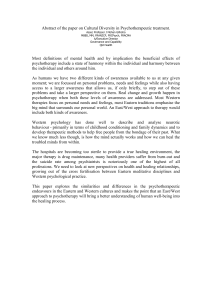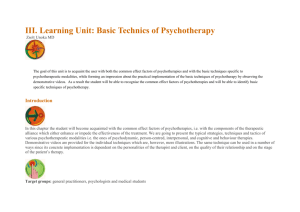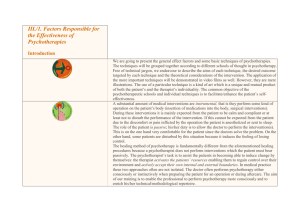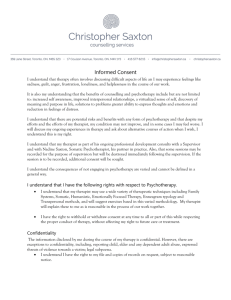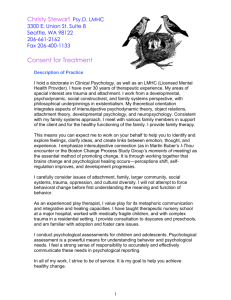II. The Indications of Psychotherapy and the Psychotherapeutic
advertisement
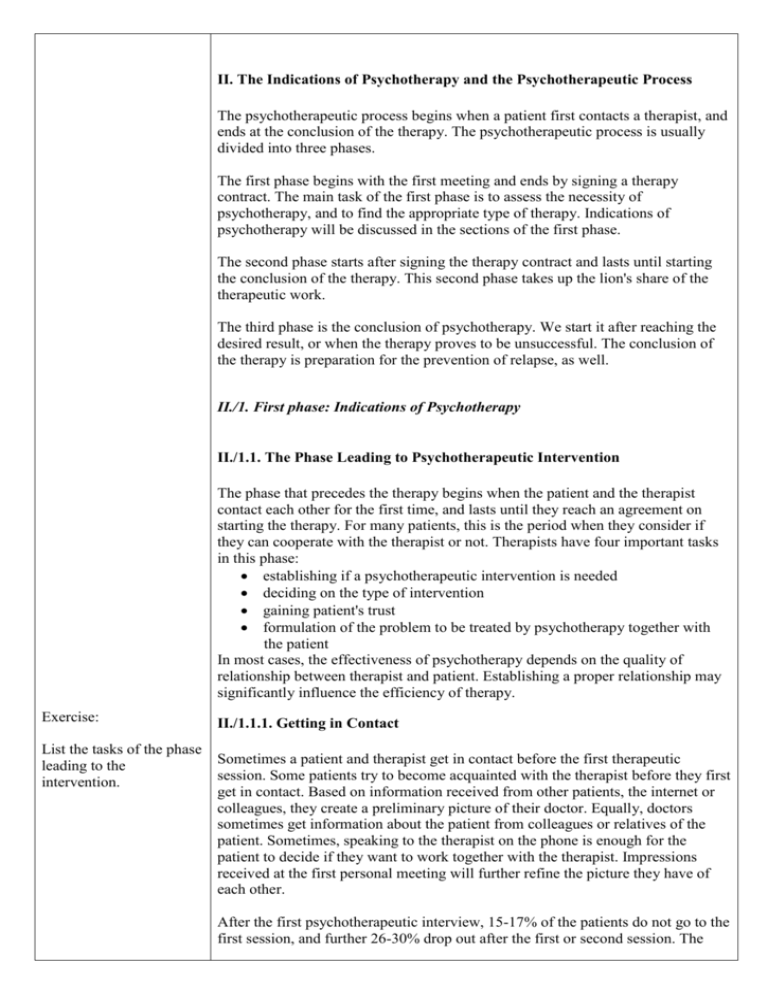
II. The Indications of Psychotherapy and the Psychotherapeutic Process The psychotherapeutic process begins when a patient first contacts a therapist, and ends at the conclusion of the therapy. The psychotherapeutic process is usually divided into three phases. The first phase begins with the first meeting and ends by signing a therapy contract. The main task of the first phase is to assess the necessity of psychotherapy, and to find the appropriate type of therapy. Indications of psychotherapy will be discussed in the sections of the first phase. The second phase starts after signing the therapy contract and lasts until starting the conclusion of the therapy. This second phase takes up the lion's share of the therapeutic work. The third phase is the conclusion of psychotherapy. We start it after reaching the desired result, or when the therapy proves to be unsuccessful. The conclusion of the therapy is preparation for the prevention of relapse, as well. II./1. First phase: Indications of Psychotherapy II./1.1. The Phase Leading to Psychotherapeutic Intervention The phase that precedes the therapy begins when the patient and the therapist contact each other for the first time, and lasts until they reach an agreement on starting the therapy. For many patients, this is the period when they consider if they can cooperate with the therapist or not. Therapists have four important tasks in this phase: establishing if a psychotherapeutic intervention is needed deciding on the type of intervention gaining patient's trust formulation of the problem to be treated by psychotherapy together with the patient In most cases, the effectiveness of psychotherapy depends on the quality of relationship between therapist and patient. Establishing a proper relationship may significantly influence the efficiency of therapy. Exercise: List the tasks of the phase leading to the intervention. II./1.1.1. Getting in Contact Sometimes a patient and therapist get in contact before the first therapeutic session. Some patients try to become acquainted with the therapist before they first get in contact. Based on information received from other patients, the internet or colleagues, they create a preliminary picture of their doctor. Equally, doctors sometimes get information about the patient from colleagues or relatives of the patient. Sometimes, speaking to the therapist on the phone is enough for the patient to decide if they want to work together with the therapist. Impressions received at the first personal meeting will further refine the picture they have of each other. After the first psychotherapeutic interview, 15-17% of the patients do not go to the first session, and further 26-30% drop out after the first or second session. The first impression is found to be a determining factor in many aspects of life. The discussion of the patient's ambivalent feelings about therapy can help them a lot in making a decision. II./1.2. Setting up a Diagnosis The problems of the patient are to be diagnosed before the beginning of psychotherapy. In medical practice, the first step in setting up a diagnosis is the separation of the mental and physical illnesses of the patient. Should the doctor find any mental diseases, assessment of the nature of the problem, and consideration of the treatment to be chosen, will be next steps. II./1.2. 1. Psychiatric Diagnosis In the two most frequently used diagnostic systems (BNO-10, DSM-IV-Tr), psychiatric diagnoses are descriptive. Psychiatric diagnostics categories are syndromes, descriptions of joint symptoms. Psychiatric diagnostic systems tend to avoid mentioning the psychic mechanisms to be found in the background of the symptoms. Consequently, they cannot be sufficient for the planning of psychiatric treatments on their own. The DSM-IV-Tr psychiatric diagnostic system has five axes of activity: I. Psychiatric diseases and other conditions worthy of clinical attention II. Personality disorder, mental retardation III. Somatic conditions IV. Psychosocial and social environmental problems V. Comprehensive summary of functioning The first axis represents psychiatric clinical profile with the exceptions of those chronic conditions belonging to the second axis, such as personality disorders and mental retardation. Several psychotherapeutic schools (cognitive-behavioural therapy) develop specific treatment programs for each and every diagnostic category. Other schools adopt general psychotherapeutic principles facilitating the development of personality as a whole (person-centred and psychodynamic). Important The assessment of personality disorders belonging to the second axis is inevitable for the planning of psychotherapy. In order to find the adequate intervention, it is important to assess if the patient has chronic, maladaptive personality traits that require specific psychotherapeutic methods. The third axis serves for the description of somatic conditions and physical illnesses. Somatic disorders are sometimes in causal connection with one another (depression caused by hypothyroidism) in which case the treatment to be selected in first place is to cure the somatic disorder. Psychotherapeutic interventions are considered as supplementary treatments, primarily aimed at reducing stress caused by the disease. In other cases, etiologic connection between somatic and mental disorders is not clear. The fourth axis represents psychosocial and social environmental problems which notably influence the formation, diagnosis, treatment and prognosis of mental disorders. The questionnaire attached introduces the most important psychosocial stressors. In the planning of psychotherapy, it is always important to see which circumstances are more likely to be found in the background of the patient's disorders: inner processes or social environmental factors. On the fifth axis, we assess the comprehensive level of functioning on a 100-degree scale (A_P_2_Melléklet_ II_1_1_2_ 1_GAF). The level of functioning determines the urgency, location, objective, frequency, duration and intensity of the treatment (hospital or outpatient, psychotherapeutic, sociotherapeutic, medical or other biological treatments). Important Read the GAF scale o 1-20 GAF scores – the patient is a danger to the public or themselves, and is not able to take care of themselves, is in need of treatment in a locked psychiatric ward or in an ICU (intensive care unit). o 21-40 GAF scores – the patient is in need of hospital treatment. The patient is characterized by significantly damaged reality testing and social conditions. In most cases, medicinal treatment is also required. Stabilization of behaviour and emotional state, enhancement of correct reality assessment, improvement of social skills, developing the system of social support and cooperation with medical treatment are the most essential interventions. o 41-60 GAF scores – the patient shows severe psychic symptoms (suicidal fantasies, compulsive symptoms) and/or has serious social, occupational or school related problems. Frequent observation, medicinal and/or psychosocial treatments are also required in their case. They are in the need for communal psychotherapeutic treatment, family intervention and social skillbuilding interventions. In the case of dysfunctional personality characteristics, long term interventions are also needed. o 61-80 GAF scores – indicates moderate and temporary symptoms. The length of psychotherapeutic intervention depends on whether the symptoms are temporary or situational (GAF 71-80), or are largely determined by dysfunctional personality characteristics or interpersonal problems (GAF 61-80). For children and adults experiencing relationship problems and with GAF scores of 61-80, relationship therapy and family therapy can be useful. o 80-100 GAF scores – are within the normal range. However, shorter consultations are sometimes required, especially at time of difficult life situations such as stress caused by illnesses. Literature: Beutler, L. E., Consoli, A. J., & Lane, G. (2005). Systematic treatment selection and prescriptive psychotherapy. In J. C. Norcross & M. R. Goldfried (ed.), Handbook of psychotherapy integration. (2nd ed.). New York: Oxford University Press. II./1.2.2. The Most Important Dimensions of Psychotherapeutic Diagnosis II./1.2.2.1. The Ability to Fulfil Essential Needs The positive objective of psychotherapy is to reach a state of psychic health. Psychic health can be defined in many ways. According to one possible definition, in the case of psychic health the person is capable of fulfilling their essential needs in a harmonic way, without restraining others by breaking the rules of social cohabitation. Different psychotherapeutic schools describe essential needs in different ways. Hereinafter, you find a list of needs that are considered essential. One of the most important tasks of setting up a psychotherapeutic diagnostics is to find the essential needs that the patient struggles to fulfil. Basic needs: Social needs. Affection, intimacy, sexual life, relationship, friends, workplace relations, integration into larger groups are all important elements of our lives. It is necessary for humans to feel safe in such fields and to feel that their relationships are stable. They must feel accepted and that they can rely on care from others. The therapist monitors if there are any people to bond with in the life of the patient and if the patient bonds to them safely or not. It is important to reveal if the patient is able to maintain an intimate relationship, can feel good in the company of others, if they live an enjoyable sexual life, if they can establish a lasting relationship based on mutual care, if they have friends, if they can integrate into their work environment, and if they can realise their own interests. ! Inner barriers to realising needs: o Abandonment: Conviction of the patient that they cannot rely on others. o Mistrust/Abuse: Others want to abuse them. o Defectiveness/Shame: If their defects are revealed, they will be desolated or humiliated. o Emotional deprivation: they cannot expect care, appreciation, support. o Social isolation: Not belonging to social groups. Needs for independence. Are they able to make decisions in crucial and everyday matters? Do they have the chance to make such decisions? It is important to distinguish personal autonomy from limitations arising from external circumstances. Inner barriers to realising needs: o Failure to achieve: Unable to complete tasks independently. o Lack of self-reliance: Patient does not dare to make decisions independently. Competency-related needs. Is the patient in possession of the skills necessary to reach their goals? These skills can be social or the workrelated ones necessary to perform tasks in the workplace. Internal barriers to realising needs: o Feeling of incompetence: Don't consider themselves to be able to live an independent life. Identity-related needs. Patient believes they have an independent and communal identity as well, that is, they belong somewhere (language, religion, job, habits, values and norms) to which they are devoted. One identity does not interfere with the other; that is, the patient does not have to be afraid of interfering with the social identity when representing their own identity, or losing the support of people important to them. The patient has due self-esteem. Important Internal barriers to realising needs: o Enmeshment: The patient feels they cannot have their own identity, as that would damage their important personal relations. Freedom of expressing justified demands and emotions. Can they express their feelings, desires, and needs, in the company of others? Can they start negotiations, standing up for their rights in an assertive way, even if the other person has other thoughts on their minds? Internal barriers to realising needs: o Subjugation: they do not dare to stand up for their needs, desires, emotions, because they are afraid of displeasing the other or being punished or abandoned by them. o Self-sacrifice: Patient surrenders their own desires in order to please others. o Approval-seeking / recognition-seeking: In order to gain appreciation, admiration of others, the patient conforms to others’ needs, and gives up their own demands for the sake of being appreciated. Spontaneity-related needs: Can they relax or engage in playful activities with others. Do they have creative ideas? Internal barriers to realising needs: o Perfectionism: Aspiration for perfection takes away time from relaxing and from social relationships. o Emotional inhibition: repression of expressing positive or negative emotions. o Negativism/Pessimism: Always expects bad things to happen, consequently, cannot live a relaxed life. o Punitive attitude: Expects punishment for the tiniest fault. Respect for the needs of others: Can they notice the needs of others, can they negotiate a compromise in the case of a conflict? Internal barriers to realising needs: o Entitlement / grandiosity: The person feels superior to rules of social cohabitation. They believe that others are required to fulfil the patients’ needs. Important Skills in delaying the fulfilment of needs; need of self-control: Can they delay the momentary satisfaction of their needs in order to reach longerterm goals? Internal barriers to realising needs: o Insufficient self-control/impulsiveness: The patient acts in response to their momentary desires, motions, inspirations and feelings without considering the possible long-term outcomes of their actions. Essential conditions of life: The most essential motivations are aimed at staying alive and living life in health. Food, drink, place to live, opportunities for hygiene, physical, financial, legal and political security. In the initial phase of psychotherapy, the most important task is to reveal the essential needs of the patient and the main impediments to realising them. In optimal circumstances, all interventions of the psychotherapist are aimed at making the patient aware of their essential needs, and supporting them in enforcing such needs. Psychic conflict: One possible result of the assessment of needs can be the identification of psychic conflict of the patient. A situation we consider a psychic conflict is when inner contradiction between two essential needs hinders the fulfilment of one of these needs. For example: The need for independence is in conflict with the need for affection. Some are afraid that others will be angry if they fulfil one of their own wishes. Literature: Young, J. E, Klosko and J.S, Weishaar M. (2003) Schema Therapy: A Practitioner’s Guide. The Guilford Press. New York, London. II./1.2.2.2. Coping Style of Personality Barriers to fulfilment of essential needs cause frustration that people try to cope with using different coping strategies. Congenital temperament traits strongly influence the nature of dominant coping styles of a given person. Below you find a list of typical coping styles: Coping by internalization – people using this strategy believe that circumstances resulting in negative situations occur due to their own faults, whilst they form a positive image of others. Results of this strategy are timidity, self-reproach, and sense of guilt, shame and restrained emotional life. It is psychodynamic therapy that best matches those tending to this coping style. Exploration of relationship patterns that doubt the justification of their needs and impulses can help them a lot. Repression mechanism – people using this strategy tend to avoid becoming conscious about impetuses and emotions considered to be threatening by the psychic manoeuvres of selective inattention or denial. They often fail to realize their aggression, sexual incentives or other emotions, and they only experience physiological changes accompanied by emotions. It is recommended to carry out psychotherapeutic, therapeutic work aimed at discovering correlations between cognitive, physical, behavioural and emotional experiences. The identification of emotions and relationship patterns activated during therapeutic relationship and the development of alternative coping methods are important interventions. The exposure of early childhood experiences related to the regulation of feelings is sometimes necessary. Exercise: Think if there are internal hindrances in relation to the realising of your own needs? Coping by externalization – Patients belonging to this group are impulsive, imprudent. They are characterized by angry outbursts. When they make a mistake they tend to blame others for their problems. A paranoid tendency can be observed in their case: because of their own constant distrust, and because of feeling threatened, they regard others as threatening, and they attack others as if they were responding to an attack. In these situations, the objective of the treatment is to make patients understand emotions, inducements, and to enable them to balance up factors, before making a decision or acting upon a decision. And, in case of need, to reconsider the situation and alter their intentions for action. Since their introspective skills are less developed, the most appropriate methods are strongly structured ones combined with skill-developing techniques aimed at realizing their emotions and reconsidering the situations, such as cognitive-behavioural therapy or mentalization-based therapy. Alternately external-internal coping style: These patients tend to keep changing the two coping styles, thus posing challenge for physicians. Sometimes they move practitioners to pity because of their sense of guilt and self-assaulting thoughts. Another time, they fiercely attack their doctors, criticizing their personality and work. Their self-judgment varies between acceptance and hatred, and that of their doctors between admiration and contempt. Their behaviour varies between complete withdrawal and aggression and impulsive, aggressive behaviour. The treatment of such patients can be carried out by professionals trained in transference-focused therapy, scheme therapy, mentalization-based therapy or dialectic behavioural therapy, otherwise, the treatment of patients will terminate earlier in many cases, and sometimes inappropriately conducted psychotherapy may be harmful for the patients. II./1.2.2.3. Willingness for Cooperation and Resistance In the course of the therapy, cooperation and resistance can suddenly vary due to the traumatic nature of problems and tasks. Therapists constantly have to monitor changes in the degree of cooperation. The skill of cooperation as a personality trait can also be observed. For some patients, it is easier to maintain a cooperative relationship. Directive techniques can be easily applicable in their cases. However, it is often difficult for them to give feedback when the therapist is going in the wrong direction. Cooperative patients usually have a positive reaction to directive, cognitive therapeutic methods. Other patients often resist therapy, considering the intervention of the therapist as an attack threatening their independence. Non-directive techniques and paradox interventions are recommended in their case. If the patient wants to avoid the exposure of their life-long problems, then the best way for the therapist is to consider the patients’ demands for autonomy as valid and switch to a nondirective approach. In the case of paradox intervention, they try to forbid a “over early transition”, or, in the case of a resisting patient, it is recommended to act following their symptoms. The objective of this is to hand over the control to the patient, as a result of which they realize that they can handle their symptoms consciously. This can help them get rid of these symptoms by their own will (as a resistance to the recommendation of the therapy). II./1.2.2.4. Assessment of the Degree of Motivation Assessment of the degree of the patient's motivation for a change is an invaluable part of setting up a diagnosis which prepares psychotherapy. Prochaska, Norcross and DiClemente (2009) provide a list consisting of five levels related to the inclination for change. When planning a therapeutic intervention, the motivation level of the patient must be considered. Pre-contemplation – the phase before contemplation: The patient does not recognize the problem, is not willing to change it. They deny the existence of the problem and believe it is related to others. Goals of the therapy: o establishment of therapeutic relationship o reduction of symptoms o enhancement of consciousness: providing information on the nature of psychotherapy clarification of anxiety and shame related to taking part in a psychotherapy gentle revelation of the essence of the treatment o motivation interview we have to help patient recognize the discrepancy between their future objectives and actual behaviour. Contemplation: The patient has already realized the problem, and is considering a change. However, they have not committed to change. Ambivalent. Goals of the therapy: o Conceptualization of the problem by functional analysis: Reconsideration of the relations between their own selves, others and their surroundings helps the patient realize patterns of the root causes, consequences and recurrence of their problems. Problematic behaviour is generated by root causes. Then, its consequences re-compensate patients in the short-term in spite of its negative long-term consequences. o Development of hope in possibility of a change: If the patient understands how their problems come to being, why they remain and understands their own roles, then they have more trust in being able to change. o Revelation of life-long problems: Another reason that renders changes more difficult is that patients think that the problem is an integral part of their personality. Identification of relationship patterns and maladaptive coping methods impeding the fulfilment of basic needs, and the exploration of the background thereof in their childhood can help patients separate the problems to be changed from the healthy parts of their personality. o Making a balance sheet of decisions: in the attached chart you find an example for a balance sheet of decisions. A_P_1_Tablazat_II_1_1_2__2_4_Dontesi_Merleg Phase of preparation: In this phase, the patient has already considered the possibility of change. Arguments for a change prevail in this phase. Commitment is established, which means, that the patient already believes in the change. Phase of taking action: Patient starts making changes. They start to change their behaviour, appraisal of situations, or they start to reshape their environment. Goals of the therapy: o Starting behavioural changes, in the case of behavioural problems o Making them aware of the patterns and schemes dominating their behaviour, and advance the development of new alternative beliefs and relationship patterns o Understanding and changing internal and external reasons that generate the recurrence of the problems. Development of strategies for prevention. Phase of protecting the changes achieved: The objective is the solidification of results achieved. In this phase, a particularly important task is to prevent relapse. o We distinguish slips from relapses. Phase of relapse to a previous level: In most cases, changes are not linear, they usually take place in spiral cycles. It means that following the acquirement of new skills, ways of relationship, outlooks on life, we, at times, relapse to a state of mind which is similar to the one before. But fortunately, it is not exactly the same state, as that earlier state of mind also becomes different due to our newly acquired knowledge. In the course of psychotherapy, different problems are brought to the surface. Also, changes in the levels of motivation can often be experienced. For example, a patient, called Zorka claimed she could not work effectively; she is unable to finish her tasks deferred termination other tasks. Consequently, she was anxious and depressed; she underrated herself and was irresolute and not able to enforce her will. She finally decided to ask for psychotherapeutic support in the hope of a change. In order to change, she entered the phase of action, because she wanted to finish her tasks on time. However, after having been faced with her relationship patterns, found in the background of her symptoms, she does not dare to stand up for their needs, desires, emotions, because she is afraid of displeasing others or being punished or abandoned by them. And she should change this habit of avoiding conflicts, but she temporarily slipped back to the contemplation phase because she does not dare to stand up for her goals. Later, she succeeded in doubting the justification of these patterns, and the need for a new, more adaptive pattern gained strength. After she put this new recognition into practice, it induced a strong resistance in her partner which put their relationship in danger. This set the patient back to the contemplation phase. Literature: Prochaska JO, Norcross JC, DiClemente CC.: Changing for Good: A Revolutionary Six-Stage Program for Overcoming Bad Habits and Moving Your Life Positively Forward. William Morrow Paperbacks. 2007 II./1.2.2.5. First Psychotherapeutic Interview The goals of the first psychotherapeutic interview are complex, and the therapist often has to resolve conflicting tasks. Support patients in telling their story Establish a collaborative therapeutic relationship Find answers to the above described diagnostic aspects Make decisions about the necessity of the therapy Assess of eligibility for psychotherapy o level of motivation o counter-motivations o resistance Determine therapeutic goals Elaborate therapeutic concepts Select methods Assess the expected results Provide motivation Possess therapeutic experience Listening to the story of the patient with empathy has a good influence on the establishment of a collaborative therapeutic relationship. Patients may feel that questions to gain sufficient information are like an inquisition which may induce negative feelings in them. At the same time, questions that fit the personal narrative of the patient and show expertise and knowledge of the problem will bring about trust and boost the motivation of the patient. The first therapeutic interview leads to the first case conceptualization which is shared with the patient. II./1.2.2.6. Case Conceptualization Case conceptualization is a basic psychotherapeutic skill. It is a starting point from which the therapist creates hypotheses about the risk, the causal and the sustaining factors of the psychic, social and behavioural problems of the patient. Case conceptualization needs to be modified from time to time, according to tests and new information. Case conceptualization helps the therapist arrange information gained from the patient in a way which can be used for the purposes of the therapeutic method. Patients often present conflicting statements and behaviour patterns. Therefore, case conceptualization must be developed so that conflicting data are reconciled. An elaborated conceptualization can greatly help the work of the therapist. Also, a sympathetic approach of the therapist has a favourable therapeutic influence on the patient, in itself. In most psychotherapeutic methods, patients are informed of the results of case conceptualization. This also proves to be fruitful when conceptualization is performed together by the therapist and patient, which they continuously modify throughout the therapy. Nevertheless, the tolerance capacity of the patient must always be taken into consideration, and the result of case conceptualization should be revealed to them to an extent that they can handle well. The goal of case conceptualization is the advance planning of the treatment. The therapist: identifies of the goals of the therapy outlines the process of therapy outlines the possible barriers in advance provides a list of strategies, tactics and techniques that facilitate the goals to be achieved Case conceptualization has different methods in every psychotherapeutic school. An example will be analyzed according to the methods of two psychotherapeutic schools: The core conflict relationship theme is a case conceptualization method of the psychodynamic school. It is based on the observation, that people formulate a picture in the course of their development about other people’s reaction to their expression of needs. Later this becomes a model that can have a huge influence on how they experience their relationships. Three questions are raised when formulating the core conflictual relationship theme : o What are the patient's expectations of others? o What kind of reaction does the patient expect from others and how do they react in reality. o How does the patient react to hypothetical or real reactions of others? Chart 2. Zorka’s core conflictual relationship theme. P_2_Tabalazat_II_Kozponti_kapcsolati_konfliktus_tema In the course of case conceptualization in the cognitive therapeutic school, they examine basic patterns that impede the fulfilment of essential needs and coping styles: o What are the basic needs that the patient is not able to fulfil? o What patterns are activated by the desire to fulfil these needs? o What negative automatic thoughts does the patient have? o What coping methods does the patient apply to cope with the reality distorted by patterns? Chart 2. Zorka’s Cognitive case conceptualisation sheet. A_P_3_Abra_II_Kognitiv_Esetkonceptualizacio_Zorka II./1.1.2. 2.7. Therapy Contract As a result of the first case conceptualization, the therapist must be able to make a decision on the necessity of the therapy, its location, method, duration, frequency and its realistic goals. In view of this, the therapist makes an offer to the patient in reference to the therapy and discusses the details of treatment with them. In most cases, the therapy contract is a verbal agreement between the therapist and the patient: they agree on necessity of the treatment and that they start the treatment they come to terms with the goals of the treatment, instruments to reach these goals, i.e. their tasks they agree on the exact frame of the treatment o duration of treatment o frequency of sessions o duration of one session o place of treatment o cost of the treatment (social insurance or the price of therapy, in the case of a private therapy) they agree on the rules to apply when the frames of the therapy are violated o conditions of cancelling a session o how to deal with delayed arrival o handling the duration of sessions Different psychotherapeutic schools apply different therapy contracts. For example, in behavioural therapy they often use written contracts related to the exact changes of behaviour. In the case of hospital treatment, staff often have instructions in the written contract, concerning dining control, or other controls of behaviour, as instruments to control the behaviour of the patient. At the end of the first interview, we ask the patient to give feedback in relation to the case conceptualization and the therapy contract. It is recommended to provide the patient with tasks to be completed before the next session in order to make them feel an active participant in the change. Homework for patients in resistance is not recommended in this phase of the treatment.

